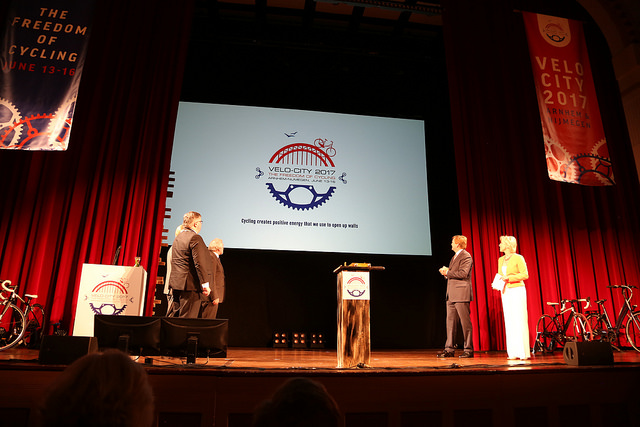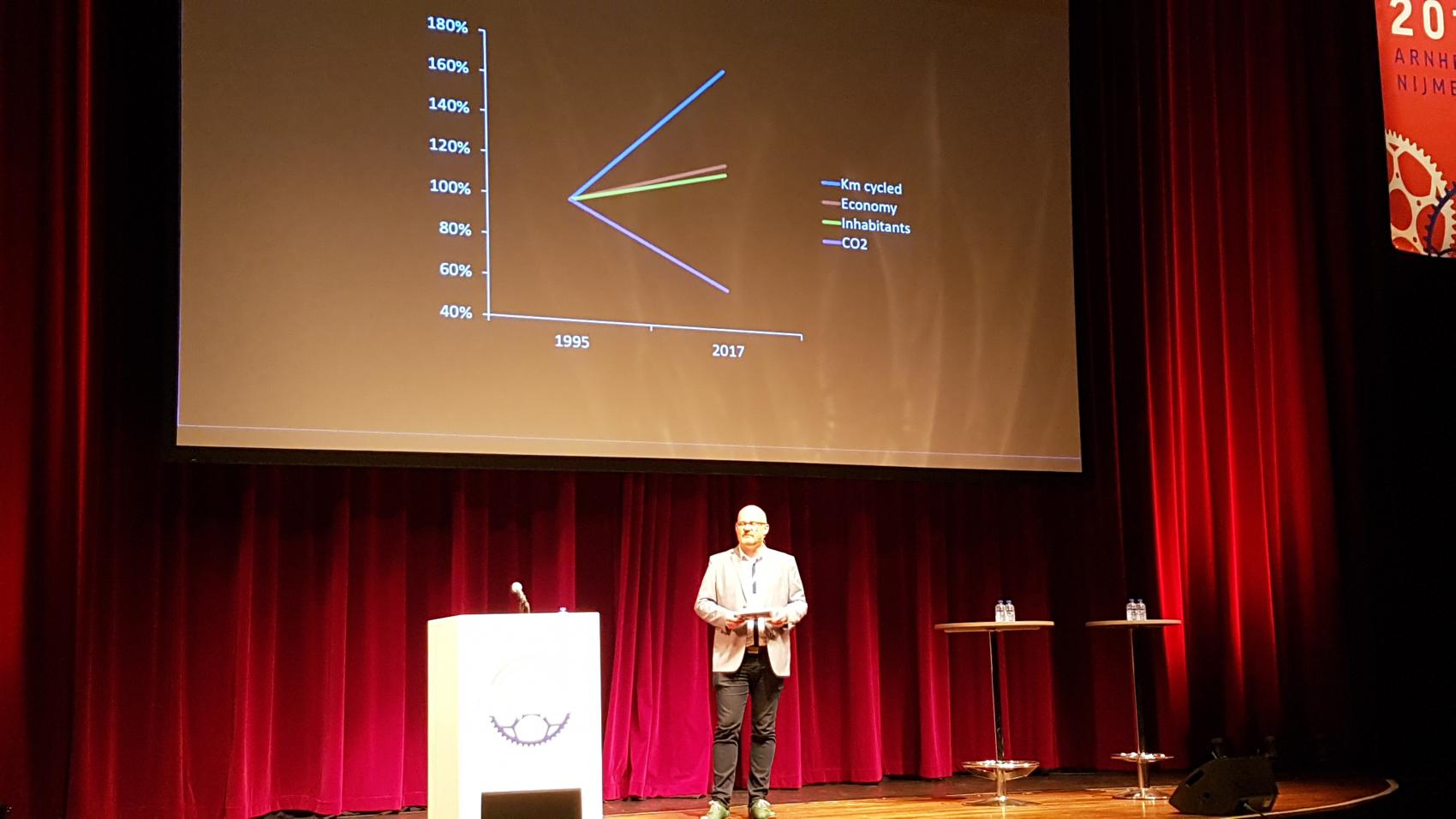
Day 01 at Velo-city 2017 [13th June]
World’s biggest cycling conference takes off with record numbers & royalty
With more than 260 speakers from all over the world Velo-city started today not only with record numbers but also with a spectacular opening by His Royal Highness King Willem-Alexander.
During the opening ceremony Tuesday morning in the conference venue of the Vereeniging in Nijmegen, His Majesty King was present to officially open Velo-city 2017 in Arnhem-Nijmegen. Together with Mayor Staal from the municipality of Arnhem, Mayor Bruls from the municipality of Nijmegen and President of the European Cyclists' Federation and the World Cycling Alliance, Manfred Neun, His Majesty Willem-Alexander the King of the Netherlands came on stage to officially open the world's biggest cycling summit.
"The mission of the European Cyclists' Federation and all of its networks is to give people around the wrold the possibility to enjoy the freedom of cycling" said Manfred Neun in his opening speech.
The motto of the conference is ‘The Freedom of Cycling’. Governance, Infrastructure, People, Bikenomics and Urban Planning are the main topics on the table. The Dutch story and the relation between health and sustainability will also be explored in numerous sessions.
"Arnhem and Nijmegen have known for a long time that to improve quality of life you must make room for cycling. We are proud to be a cycling region", said Hubert Bruls, Mayor of the City of Nijmegen.
Velo-city in numbers
Velo-city 2017 in Arnhem-Nijmegen is the biggest in its kind so far. This year’s edition not only welcomes more than 1.500 delegates, but it also offers the biggest number of speakers and sessions in the history of the series of Velo-city conferences. Over 260 speakers will bring their view on all sorts of cycling related topics in the coming days, offering a stunning 107 sessions. A total of 60 outdoor sessions and excursions are added to the program to show delegates more of the Arnhem-Nijmegen cycling region. The expo at the Vereeniging houses a 100 different booths from exhibitors from all over the world. 230 volunteers covering over 600 shifts will make sure all runs smoothly.
Read the full press release here.
Reaping Economic Benefits of Lower Congestion through more cycling
 Out of the numerous benefits of cycling, this session focused on the effects of more people riding their bikes on traffic congestion. The European FLOW (Furthering Less Congestion by Creating Opportunities For More Walking and Cycling) project is currently studying these effects. The aim is to put walking and cycling on an equal footing with motorised modes as a solution to tackle urban congestion, by developing a user-friendly methodology, involving traffic modeling, to assess the effectiveness of walking and cycling measures, thus linking the worlds of cycling and walking with the one of transport planning.
Out of the numerous benefits of cycling, this session focused on the effects of more people riding their bikes on traffic congestion. The European FLOW (Furthering Less Congestion by Creating Opportunities For More Walking and Cycling) project is currently studying these effects. The aim is to put walking and cycling on an equal footing with motorised modes as a solution to tackle urban congestion, by developing a user-friendly methodology, involving traffic modeling, to assess the effectiveness of walking and cycling measures, thus linking the worlds of cycling and walking with the one of transport planning.
Several countries and cities have already discovered the positive effect of cycling on road congestion and introduced corresponding measures. For example, the Netherlands, faced with an expected rise of 40% in traffic jams, has started the “Beter benutten” (“Optimising Use”) programme, whose goal it is to improve accessibility in the twelve busiest regions of the country by optimising the use of existing infrastructure. Promoting cycling is a central part of programme, for example through smartphone apps, cycle highways or incentives to use e-bikes. Besides reducing congestion, there are a lot of other co-benefits, for example through reduced costs in the public health system.
The city of Copenhagen has made similar experiences. Increasing cycling has made the city more efficient by creating flowing traffic instead of clogged streets. The city aims for a modal share of cycling of 50%, and the city administration is convinced that increasing cycling and decarbonising the municipality can be reconciled with a growing population and economy, creating a liveable and prosperous city.
In Valencia, politicians have just started to walk (and cycle) on the path shown by Copenhagen and Dutch cities. With a big amount of political determination, it is building separated and connected cycling infrastructure, supporting cyclelogistics and organising bike festivals, capitalising on the good preconditions of a flat topography and around 300 days of sun per year. The city administration is convinced that it can renew the bike culture just as Amsterdam and Copenhagen did a few decades ago.
In their concluding remarks, the speakers agreed that current traffic models are not including cycling in a correct manner and that they are too car-centred – so the results of the FLOW project will be very useful for them.
Written by: Holger Haubold, ECF Fiscal and Economic Policy Officer
What Gets People Cycling?
There may be some barriers that keep people from cycling, but there are at least as many creative and innovative projects that manage to break down these barriers. This session featured four examples from around Europe that show how a long-lasting motivation for cycling can be created.
The group Pro Velo from Belgium presented some of its projects that have the aim to make more people cycle in Brussels and Wallonia according to the motto “Cycle once, cycle everywhere!” For example, the “Bike Experience” brings together voluntary bike coaches from the Brussels cycling community with citizens that want to take up cycling. Working together with the regional administration, this project has achieved a very high long-lasting modal shift: 83% of the participants keep on cycling.
The Bike2work project in Italy, part of a European project with the same name, uses Fogg’s behaviour theory to increase cycling commuting by creating motivators, ability, and triggers. Motivators are for example peer group motivation, empowerment, and discovery. Ability includes having access to a bike, knowing how to repair tires and knowing the best routes. Finally, triggers are rewards in the form of prices or the sharing of experiences on social media.
The province of North Brabant, rather than addressing citizens directly, has chosen to work with employers and inspire them to do more for cycling to work in a special campaign. By creating an employers’ platform with a communication manager, it has given companies a space to share experiences and best practices and to receive practical assistance in making their businesses more bike-friendly for employees.
Finally, the city of Copenhagen has managed to increase the share of cycling in short trips from 38% to 42%, while at the same time decreasing the share of car-driving from 18% to 15% by introducing campaigns targeting the main reasons why people do not cycle:
- Broken bikes: The city has created bicycle repair events in recently developed areas which do not have neighborhood bike shops yet. 25% of participants said they would use their bike more in the future for short trips
- Insufficient knowledge about pleasant routes: Informing about existing green cycle routes through brochures and a route planning app that gives the possibility to choose the greenest route.
- Practical reasons and safety concerns linked to children: The “Mini-Copenhagener” campaign – Affecting adults through their children: 47% of parents joining the campaign said they would walk + bike to school in the future with their children.
Written by: Holger Haubold, ECF Fiscal and Economic Policy Officer
Social Inclusion
Beyond all its physical, environmental, economic benefits, cycling also have huge social impacts, as it is the most inclusive transportation in town. Activtists from Argentina, Brazil, Australia, UK, and the Netherlands, gathered today in the cozy and suggestive Black Room to talk about their campaigns and approaches on social inclusion.
Because of how our cities are built, mobility doesn’t only give physical access to specific spaces, but it also allows for social access to jobs, communities, education, etc. Extremely interesting projects were discussed, giving unemployed people access to mobility – and therefore to opportunities for employment – giving migrants and marginalized groups free bicycles and training on how to ride them (in urban spaces); giving women the opportunity to show their love for cycling, even wearing tight dresses and high heels.
An inspiring session, showing the far-reaching possibilities bicycles offer when they stop being thought of as simple mobility tools, and start getting perceived as means of societal improvement and personal.
Written by: Niccolò Panozzo, Smarter Cycling Project Assistant
Cycling for all- what does it really mean?
The first day at Velo-city 2017 ended in greatness. Three keynote speakers bringing forth examples of how bicycles are used as tools for equality and inclusiveness.
Maria Hopman opened the session, showing the scientific evidence of the health benefits of cycling. Cycling is the best preventive medicine existent; for young and for old, for women and for men, for fit and for obese people, for white and black and Hispanic and Asian people, for rich and for poor. Cycling is good for your body and, researches show, even for your brain: being a multi-tasking activity that requires your brain to work together with your body (to keep balance, to check for arriving cars, to be aware of your surroundings, etc.), riding a bicycle stimulates your cognitive functions.
Martha Roskowski from People for Bikes, the biggest cycling advocacy organisation in the US, also gave account of the situation in the States, where for years old white men-dominated urban planning studios designed cities geographically prone to segregation. The car culture, shaping so aggressively urban areas, has had a direct impact on people’s lives, but luckily pools of activists and advocates are working together to take the city and give it back to its citizens. How? For example, creating human walls along the cycle lanes, to separate them from motorised traffic.
And finally Clarisse Linke, working at the Institute for Transport and Development Policy, just blew the roof off. Talking about the difficult situation of cities in South America, she showed the worrying conditions in which women have to ride. “In Europe, people take the security of the public spaces for granted – well, it isn’t granted in South America”, where women work in average 5 hours per week more than men; where men usually commute with their own private cars, and women have to share the road with vehicles moving at 70km/h; where less than 10% of the 1% of regular cyclists [Sao Paulo] are women; where mobility – and thus self-developing opportunities – is just not accessible to them. The conference was literally delayed because the applauses were not stopping.
Cycling is an extremely efficient tool to empower all individual, community, society; but bicycles themselves should be enabled to perform their magic. Through inclusion, diversity, democracy.
Written by: Niccolò Panozzo, Smarter Cycling Project Assistant
Regions:
Network/Project Involved:
Contact the author
Recent news!
Upcoming events
Contact Us
Avenue des Arts, 7-8
Postal address: Rue de la Charité, 22
1210 Brussels, Belgium










